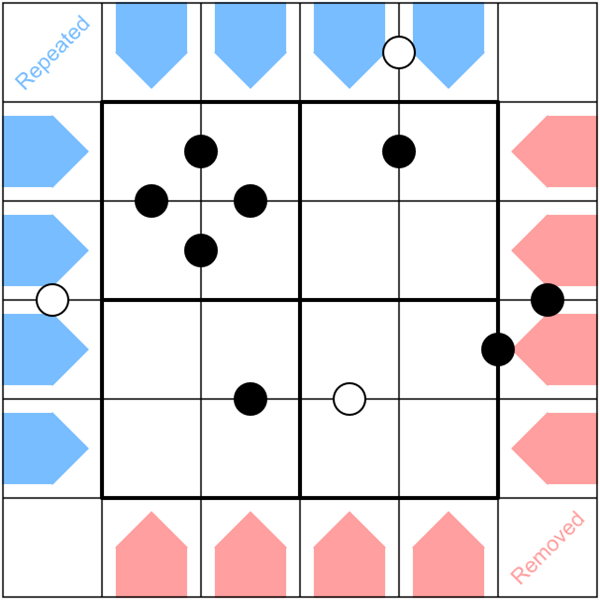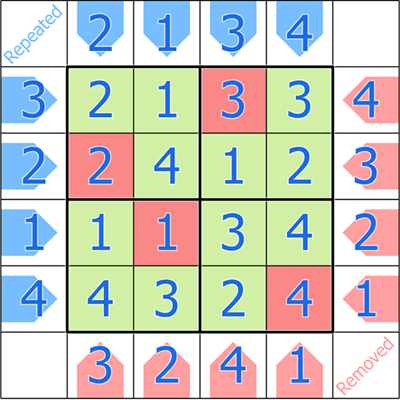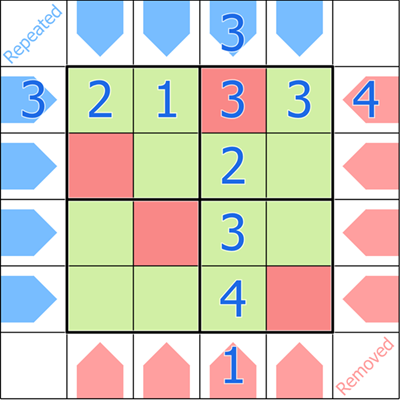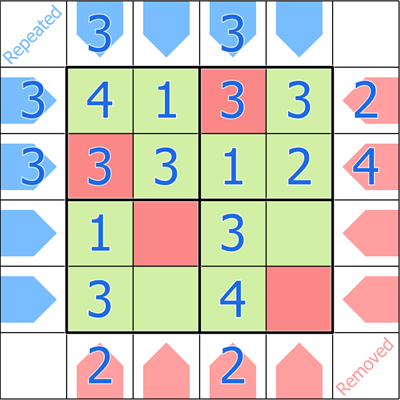Impostors Example/Snack
(Published on 1. July 2025, 18:00 by gUBBLOR)
Here's an example puzzle to get familiar with the rules of Equality Cages 142: Impostors before giving it a go. You can find an example of a correctly solved grid below, as well as a few incorrect examples with explanations of why they're incorrect. The rules may be tricky to fully comprehend by just reading them, so my recommendation is that you give the examples a quick glance before giving it a go. Alternatively at the bottom there's a link to Puzzle Patzer explaining the rules and solving both puzzles.
All my series:
Equality Cages
EquaLite Cages
Shifter Lines
Shifter Dots

Rules:
The grid contains the digits 1-4, but normal 4x4 sudoku rules DO NOT apply. There are 4 impostor digits to be found, one in each row, column, and box.
Impostors: In each row, column, and box one digit has been removed and replaced by an impostor digit, which is a repeat of one of the other digits in that row or column. I.e. 1424 would be a valid example - 3 has been removed, and one of the repeated 4s is an impostor (the solver must deduce which one).
Each digit 1-4 appears exactly once in an impostor cell. The blue arrows is used to indicate the impostor digit in that row or column. Each digit 1-4 is removed from exactly one row, exactly one column and exactly one box. The red arrows is used to keep track of these. The blue and red arrows in the same row/column need to point to the same cell (the impostor).
Kropki dots: A black dot between cells indicates cell values with a 2:1 ratio. A white dot between cells indicates cells with consecutive values. Not all dots are shown.
Solve here:
Sudokupad
Video featuring the puzzle:
Puzzle Patzer
Correct example:

The easiest way to spot that this is correct is if you remove the impostor digits and replace them with the digit in the red arrows, because then you end up with a normal solved grid. The impostor 4 in R4C4 has two blue 4s pointing at it, and both the red arrows pointing at it have the same digit. There's two 4s in both its row and column, and no 1s. Each digit appears once each in each/row column of arrows, and once each in impostor cells (of which there are one per row, column, and box).
Incorrect example:

Even though the 3 impostor have two 3s pointing at it, it's not the same digit pointing at it from the red arrows.
Incorrect example:

Even though both the row and the column have two 3s and 1s are missing, the 3 in the blue arrows aren't pointing at the 3 impostor.
Incorrect example:

There are now repeated 3s in the impostor cells, as well as repeated digits in the blue row/column, and red row/column. The impostor cells must include the digits 1-4 once each, and the digit 1-4 must appear once each in the blue row/column, and red row/column.
All my series:
Equality Cages
EquaLite Cages
Shifter Lines
Shifter Dots
Rules:
The grid contains the digits 1-4, but normal 4x4 sudoku rules DO NOT apply. There are 4 impostor digits to be found, one in each row, column, and box.
Impostors: In each row, column, and box one digit has been removed and replaced by an impostor digit, which is a repeat of one of the other digits in that row or column. I.e. 1424 would be a valid example - 3 has been removed, and one of the repeated 4s is an impostor (the solver must deduce which one).
Each digit 1-4 appears exactly once in an impostor cell. The blue arrows is used to indicate the impostor digit in that row or column. Each digit 1-4 is removed from exactly one row, exactly one column and exactly one box. The red arrows is used to keep track of these. The blue and red arrows in the same row/column need to point to the same cell (the impostor).
Kropki dots: A black dot between cells indicates cell values with a 2:1 ratio. A white dot between cells indicates cells with consecutive values. Not all dots are shown.
Solve here:
Sudokupad
Video featuring the puzzle:
Puzzle Patzer
Correct example:
The easiest way to spot that this is correct is if you remove the impostor digits and replace them with the digit in the red arrows, because then you end up with a normal solved grid. The impostor 4 in R4C4 has two blue 4s pointing at it, and both the red arrows pointing at it have the same digit. There's two 4s in both its row and column, and no 1s. Each digit appears once each in each/row column of arrows, and once each in impostor cells (of which there are one per row, column, and box).
Incorrect example:
Even though the 3 impostor have two 3s pointing at it, it's not the same digit pointing at it from the red arrows.
Incorrect example:
Even though both the row and the column have two 3s and 1s are missing, the 3 in the blue arrows aren't pointing at the 3 impostor.
Incorrect example:
There are now repeated 3s in the impostor cells, as well as repeated digits in the blue row/column, and red row/column. The impostor cells must include the digits 1-4 once each, and the digit 1-4 must appear once each in the blue row/column, and red row/column.
Solution code: A completion message with the solution code will be available when the puzzle has been solved on Sudokupad!
Last changed on -
Solved by SKORP17, PuzzlePatzer, dkfan9, marcmees, Dogdayboy, taco.bella, DiMono, josemadre, BanishedBread, zhenhao, esaqiwe, rcg, benisjammin, zrbakhtiar, pmatos, buttons, dzamie, NEWS, jcg5a, metacom, asdfg, jgarber, thefollyof, IDEK, widjo, JVA, abadx, Crul, Mr. Happy, isajo4002, stafen, Jodelbanane, Horoshamu, Raistlen, Zibl, DylanRay, yusuf17, drf93

